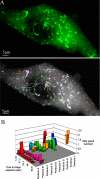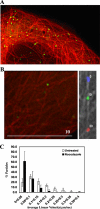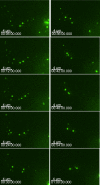TRIM5 alpha cytoplasmic bodies are highly dynamic structures
- PMID: 17392513
- PMCID: PMC1877106
- DOI: 10.1091/mbc.e06-12-1075
TRIM5 alpha cytoplasmic bodies are highly dynamic structures
Abstract
Tripartite motif (TRIM)5 alpha has recently been identified as a host restriction factor that has the ability to block infection by certain retroviruses in a species-dependent manner. One interesting feature of this protein is that it is localized in distinct cytoplasmic clusters designated as cytoplasmic bodies. The potential role of these cytoplasmic bodies in TRIM5 alpha function remains to be defined. By using fluorescent fusion proteins and live cell microscopy, we studied the localization and dynamics of TRIM5 alpha cytoplasmic bodies. This analysis reveals that cytoplasmic bodies are highly mobile, exhibiting both short saltatory movements and unidirectional long-distance movements along the microtubule network. The morphology of the cytoplasmic bodies is also dynamic. Finally, photobleaching and photoactivation analysis reveals that the TRIM5 alpha protein present in the cytoplasmic bodies is very dynamic, rapidly exchanging between cytoplasmic bodies and a more diffuse cytoplasmic population. Therefore, TRIM5 alpha cytoplasmic bodies are dynamic structures more consistent with a role in function or regulation rather than protein aggregates or inclusion bodies that represent dead-end static structures.
Figures







References
-
- Best S., Le Tissier P., Towers G., Stoye J. P. Positional cloning of the mouse retrovirus restriction gene Fv1. Nature. 1996;382:826–829. - PubMed
-
- Bieniasz P. D. Intrinsic immunity: a front-line defense against viral attack. Nat. Immunol. 2004;5:1109–1115. - PubMed
-
- Cohen P. Making a monkey out of HIV. More is becoming clear about a novel host factor that appears central to governing the species-specificity of retroviruses like HIV and could be a future antiviral target. IAVI Rep. 2005;9:9–12. - PubMed
Publication types
MeSH terms
Substances
Grants and funding
LinkOut - more resources
Full Text Sources
Other Literature Sources

